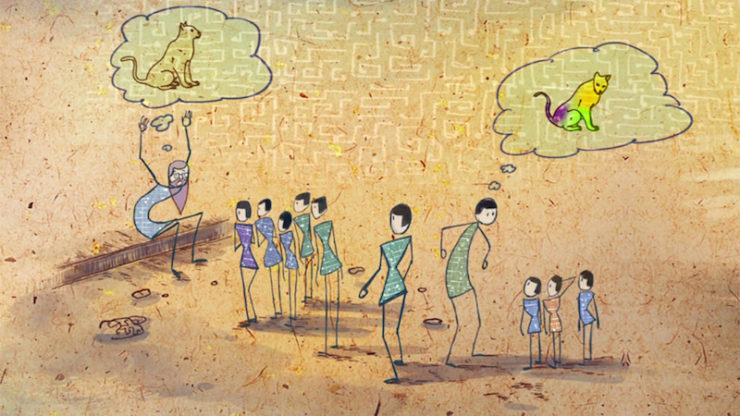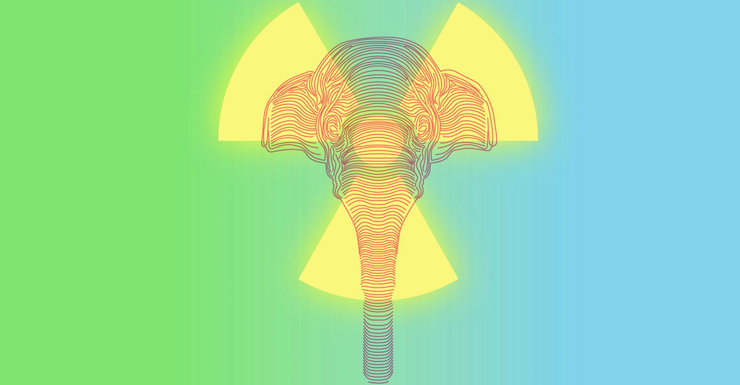There’s a reason why we haven’t heard of the atomic priesthood.
It sounds like incredible fodder for awesome dystopian stories: To protect future generations from nuclear fallout, but also to account for evolving languages and social mores, establish a religion whose “priests” pass down knowledge of how to avoid radiation zones. Knowledge, and a healthy bit of fear, zhuzhing the truth to make nuclear fallout akin to a supernatural danger—putting the fear of God, as it were, in our descendants.
So how come this concept doesn’t have its own TV Tropes page chock full of examples? Because in the 1950s and ‘60s, Isaac Asimov and Walter M. Miller, Jr. already played out that scenario in Foundation and A Canticle for Leibowitz, respectively, and found the results uninspiring: egomania, power-grabbing, and buying into their own fake dogma are just some of the reasons why human nature ruins this hypothetical scenario. So by the time that nuclear semiotician Thomas Sebeok was proposing a real-life atomic priesthood in the 1980s, the idea had already been roundly dismissed.
We narcissistic meatbags can’t be trusted with this hypothetical mission. The solution? Beg elephants to perform that emotional labor instead.
It was that weird kind of kismet that had me read Brooke Bolander’s The Only Harmless Great Thing shortly after learning about the atomic priesthood. The latter came up during some reading during Christmas break; I don’t even remember if it was a book or an article, only that it briefly lit me up inside with the spark of This would make a great play or comic book… which was immediately quashed when I did a cursory Google search and saw that it had already been tackled a few times by the greats, and subsequently already dismissed.
Or at least, dismissed in terms of humans serving as atomic priests. Because then I cracked open Bolander’s novella and found myself in an alternate present, in which scientist Kat struggles to pitch the Atomic Elephant Hypothesis to skeptical sentient elephants. An interpreter translates Kat’s—and humanity’s—monumental request into the sign language Proboscidian, because even though this scientist is asking an intelligent species to alter their very genetic code as a monumental favor to the two-leggers, she couldn’t be arsed to learn how to form basic trunk shapes to muster up at least a little bit of respect to frame her plea.

It’s a cheeky dig at humans that’s also incredibly ironic considering their dilemma, laid out in real-life government projects like the Waste Isolation Pilot Plant (WIPP): How to account for the likelihood that over the next 10,000 years, language could evolve past any written or pictorial message? Images like the nuclear trefoil or Edvard Munch’s The Scream (yes, that was proposed as an option for a cautionary symbol, seen above) could lose their current meaning; spiky protrusions from the ground or awe-inspiring structures could become intriguing instead of forbidding. How, exactly, does one condense the WIPP’s chilling message into a single symbol for 12,000 A.D.?
This place is not a place of honor.
No highly esteemed deed is commemorated here.
Nothing valued is here.
This place is a message and part of a system of messages.
Pay attention to it!
Sending this message was important to us.
We considered ourselves to be a powerful culture.
Just what are humans like Kat actually asking? That the elephants, whose memories stretch back far longer than the two-leggers’, and who will outlive these irresponsible troublemakers, agree to add jellyfish genes into their DNA so that they will glow when in the presence of radiation. As organic beacons treading over the irradiated lands, they will so resemble the ominous figures of children’s scary stories that humans will be too repulsed to ever consider setting foot on those lands.

At a recent event for the book, Bolander cited the real, ‘80s-tastic idea of “The Ray-Cat Solution”:
Bolander: In the ‘80s—so I’m assuming there was cocaine involved—a group of scientists came up with this idea: why not genetically engineer cats that change color when they’re near radioactivity? Because they figured that cats will always be popular. People will always like them. So they’d start telling stories about these cats, and a folklore would grow up around them.
[Amal] El-Mohtar: WHAT.
Bolander: Yeah, it’s called “The Ray-Cat Solution.” But then they were like… why don’t we try… a sign.
Familiarity isn’t the key, you see. It’s not enough to have a beloved mascot meowing friendly reminders, the same as putting vestments on nuclear priests will muffle their difference rather than emphasize it. Folding the warning into dogma still runs the risk of being ignored, or inverted, or taken for granted. No—the warning, like the archetypal trefoil, must be something feared. It must inspire a visceral reaction in the pit of the stomach, in the back of the brain—something that can’t be articulated, but can only be responded to.
In the early 1980s, the U.S. Department of Energy’s Human Interference Task Force (HITF) commissioned a report with potential proposals for deterring descendants from treading on irradiated ground. While Sebeok’s atomic priesthood idea was left off the final report, he made a keen argument for the message’s medium, suggesting that “information be launched and artificially passed on into the short-term and long-term future with the supplementary aid of folkloristic devices, in particular a combination of an artificially created and nurtured ritual-and-legend.” A new tradition of fake legends, he argued, would eventually lead to “accumulated superstition to shun a certain area permanently.”
But wait, since when are phosphorescent elephants a primal fear trigger? …Oh, right, after Topsy.
And to produce that bone-deep superstition, you must have an inciting incident, which is where our alternate universe Topsy comes in. Topsy is always going to meet the same fate—just like Regan, a Radium Girl about to expire, she’s already dead—but Bolander limns this tragic story with the sickly green sheen of revenge. Topsy becomes active, rather than passive, in her own death. Just as her ancestor the Furmother filled her body with the Stories, too many for one form to contain, and exploded her physical form so that the Stories would return to the surface—so too does Topsy take in the poison, the knowledge, the warning and then let it rip her body apart. Topsy’s sacrifice (or sabotage, depending how you look at it) seals the elephants’ fates, forcing them to clean up after humans’ messes for generations to come. It’s another trope of folklore: the uneven trade.
And that’s the brilliance of Bolander’s take on this dilemma. Every time authors or intellectuals played out the atomic priesthood hypothetical, the priests took advantage of their position in society, or let petty squabbles eclipse their calling (you had one job, guys), or actually promoted the worship of plutonium—rather than an aversion to it—in place of a deity. Whether with nuclear power or the mere knowledge of said power, it was the retreading the same ground: give man power, and man will find a way to make it about him and fuck it up.
The Atomic Elephant Hypothesis is much less generous to its most vital participants. The elephants stand to gain nothing from this species-wide change aside from owning irradiated ground. They will not be revered, as priests would, but actively feared—those figures of fake folklore brought to harrowing life, an organic beacon to STAY AWAY. They have gotten the short end of the poisoned stick.
And that’s the missing piece: Someone, in the present, must suffer in order for this future experiment to work. It’s only fitting that it be elephants: majestic, seemingly wise creatures that humans nonetheless hunt, confine, torture. Even in our timeline, humans have already cobbled folklore and half-truths around elephants: Topsy met her end in a spectacle that may or may not have involved Thomas Edison. Elephants can paint, and feel (never mind if what they’re feeling is the brutal conditioning to hold a paintbrush). Elephants have long memories.
That, moreso than the tendency toward narcissism and the capacity for self-sabotage, may be the ultimate reason why humans can’t trust their own kind to save them: They need someone who will never forget.
If, like me, you’ve now gone down the rabbit hole, may I suggest some further reading/watching:
This fascinating explainer from 99% Invisible about how much effort went into coming up with the “memorable but meaningless” symbol for biohazard and the WIPP, with brief mentions of Ray-Cats and the atomic priesthood!
Sebastian Musch’s in-depth paper “The Atomic Priesthood and Nuclear Waste Management: Religion, Sci-Fi Literature, and the End of our Civilization,” which contextualized much of the limited conversation around the atomic priesthood in books versus real life.
Natalie Zutter might still write about the atomic priesthood, after she’s finished all of her other sci-fi plays about time travel and rogue park rangers. Brainstorm far-reaching nuclear warnings with her on Twitter!










